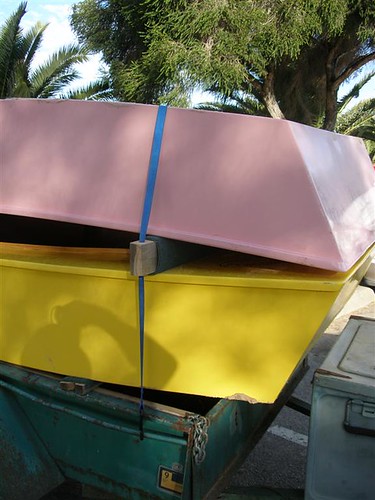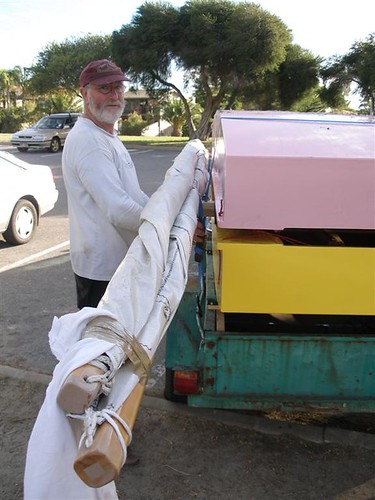I like boat trailers that have other functions too.
One way is to adapt another type of trailer – like a conventional box trailer at least for smaller boats.
An alternative is to go for something very “bare bones”.
One thing that makes a boat trailer more useful for different boats is to have a longer drawbar than normal on the trailer.
So if you are having a trailer made – adding a foot or two to the drawbar may make it useful for bigger boats too.
Most of the boats I design are pretty light anyhow.
With the dual puddle duck setup note how we have used a frame that fits in the top of the box trailer for the lower boat – no chance of that moving at all – and then use two padded cross pieces with holes in the end for the ratchet tie downs to pass through. That can’t move much either.
The frame trailer picture right is for the flat bottomed Goat Island Skiff that has two longitudinal runners on the bottom of the boat.
The cross pieces line up with bulkheads inside the boat.
If you are using a cross bar across the top of the top boat I would put holes in the ends of that for the tie down too.
The whole lot sat down very happily all the way to the recent Stansbury/Port Vincent Wooden Boat Festival.
PDRacer Trailers including a single trailer too
One pic and a little comment about the frame trailer
I would normally put plywood over the trailer frame before adding the bearers that support the boat to reduce the risk of stone chipping the hull.
A further update (2013) from Bruce a Goat Island Skiff owner in NSW, Australia. This is his boat and … trailer.
If I can offer any advice, it’s not to go the box trailer route. Because of its size (not weight) the GIS is much more easily handled on a low trailer, which facilitates one person loading and unloading. I originally used a box trailer, but the height was problematic and made handling a job for two fit and strong people.
Here is an early file pic of Hakuna Matata sitting on it’s new galvanised “Easy Trailer”. These are cheap and come delivered in a flat pack. I only had to make the front bunk. The rear pivoting bunks make loading and unloading easy as they tilt as well. I just back the trailer down to the water and when the tyres touch the water, I stop. Launching is a simple matter of lifting the bow and sliding it off into the water. The rear bunks are fixed so that the hull skids fit between them, so the boat is self-centering when loading. The long tilting bunks provide excellent support for the hull. I found I didn’t need the winch.
Loading is the exact reverse, and I could easily manage this by myself.
Michael Storer Wooden Boat Plans and Adventures in Boat Design, Restoration and Building.

